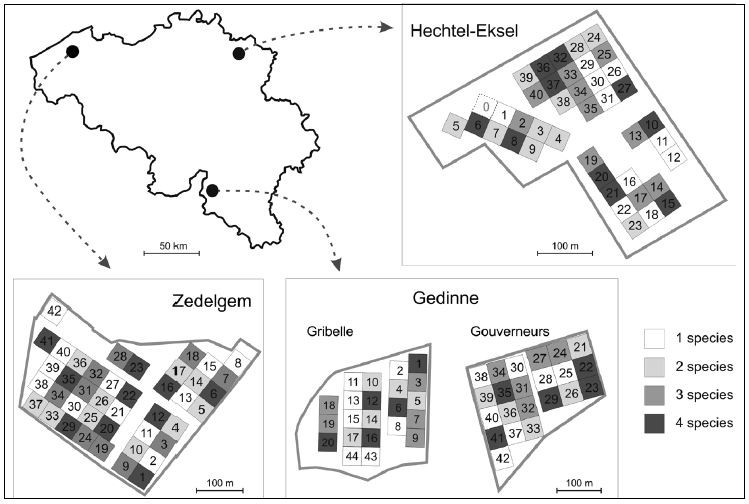FORBIO
The acronym FORBIO stands for assessment of the effects of tree species diversity on FORest BIOdiversity and ecosystem functioning. The experiment was established between 2009 and 2012. At three sites with contrasting site conditions, plots were planted with one up to four tree species. Various aspects of ecosystem functioning can thus be compared between plots that differ in tree species richness but have developed under the same abiotic conditions. The sites are located in Gedinne (Gribelle, Gouverneurs), Zedelgem and Hechtel-Eksel.

|
| Gribelle, Zedelgem and Hechtel-Eksel in 2013 (photos: Mathias Dillen & Lander Baeten) |
design
The design of the plantations follows a classical synthetic community approach, using a fixed species pool of 5 tree species in each plantation. Each site comprises 40 plots: 5 plots for each of the four diversity levels (1, 2, 3, and 4 species) and one (blocked) replication. An extra plot is left for spontaneous succession (Hechtel-Eksel). Different provenances of oak (Zedelgem) and beech (Gedinne) were used as an extra treatment; monocultures with these provenances were added (2 in Zedelgem, 4 in Gedinne). An extensive soil survey prior to the planting enabled attributing treatments and replications to the experimental plots in such a way that there is no covariation between any of the soil variables and the presence/absence of a tree species or the diversity treatments, a major strength of the FORBIO experiment.

|
| Map of Belgium with location of the tree FORBIO plantations |
Trees were planted on a 1.5 m x 1.5 m grid. In mixed plots, individual species were randomly assigned to homogeneous groups of 3 x 3 trees. Five site-adapted but functionally dissimilar species were planted per site. Each species occurs in a similar frequency, i.e., in 20 of the 40 plots, and the 2-species combinations occur in similar frequencies as well (10/40). The species pool consists of broadleaved as well as coniferous tree species that differ in, e.g., root characteristics, phenology, and shade tolerance.
| Gedinne | Zedelgem | Hechtel-Eksel |
|---|---|---|
| Acer pseudoplatanus | Betula pendula | Betula pendula |
| Fagus sylvatica | Fagus sylvatica | Larix kaempferi |
| Larix x eurolepis | Pinus sylvestris | Pinus sylvestris |
| Pseudotsuga menziesii | Tilia cordata | Pseudotsuga menziesii |
| Quercus petraea | Quercus robur | Quercus petraea |
research goals
Monitoring of ecosystem functioning started shortly after planting. Multiple processes are being measured, ranging from tree growth and tree quality development over element cycling to associated biodiversity dynamics. As the trees grow older, we plan to add more processes, e.g., water cycling, to the monitoring scheme so that the picture of ecosystem functioning in the different treatments will be as complete as possible. We try to assure that measurements are performed in all the plots, in order to include the full range of treatments, sites and processes in the analyses.
more info
For more info about the experiment, send an e-mail to the contact persons.
The FORBIO plantations are part of LTER Belgium and TreeDivNet.